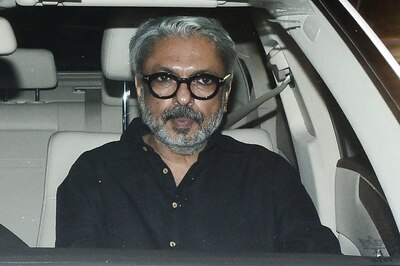
views
The North Indian and Dravidian divide is becoming a contentious issue in Indian politics, with discussions and debates centred around issues of culture, language, and identity. We get talking to the noted historian, Padma Shri Meenakshi Jain, whose new book, ‘The Hindus of Hindustan: A Civilizational Journey’ (Aryan Books), an authoritative work on the continuity of religious beliefs that bind the North and the South, busts the myths that create these divides.
The author of several significant works, including ‘The Battle for Rama: Case of the Temple at Ayodhya’, ‘Vasudeva Krishna and Mathura’ among several others, is just out with ‘The Hindus of Hindustan’ which highlights the underlying spiritual, religious, and cultural features of the Indian civilisation that remained unchanged over the millennia, thus remaining embedded in our collective consciousness and providing continuity to Bharat.
Let’s ask Meenakshi herself about this fascinating journey of hers. Excerpts of the interview:
The land mass as described in the Vedas suggests that Bharat stretches from the South of the Himalayas to the North of an ocean. Then when and how did this concept of the Union of States and Aryan-Dravidian theory come from?
The nadi sukta of the Rig Veda suggests familiarity with the land of the seven rivers, i.e., northwest India and Punjab. Other ancient texts, like the Satapatha Brahmana, record the movement eastward. The Aitareya Brahmana suggests the first crossing of the Vindhya mountains. By 500 BCE, at the latest, all parts of the subcontinent were known. The entire land was viewed as one unity. For example, Kautilya, in the Arthasastra said, from the Himalayas to the seas, the land should have one ruler. The Aryan-Dravidian theory is a political construct of much later times.
What has been the key evidence of the cultural continuity and the continuity of religious beliefs in Bharat?
The evidence of cultural and religious continuity is overwhelming. Archaeologist J.M. Kenoyer and his colleagues excavated a site at Baghor (Sidhi district, Madhya Pradesh) dated to 9000-8000 BCE. They found evidence of continuity of the female principle, in that very form, from then till modern times.
The religious continuities from the Indus Valley Civilisation downward, have been detailed by archaeologists like John Marshall, B.B. Lal, Dilip Chakrabarti, and so many others. Be it the worship of the proto-Shiva, mother goddess, tree-worship, fire-altars, reverence for water, and so much more. In addition, there were depictions of yoga postures in terracotta, agricultural practices and implements, and evidence of customs like wearing sindoor. There was no walk of life that did not reflect religious and cultural continuity.
There is also evidence of Medhatithi sharing that the Kshatriya king of excellent conduct had to conquer Mleccha land and establish a system of varnas, which suggests that Hindus historically were cultural expansionists. How did this turnaround come as a result of Hindu kings not being able to protect and save Hindustan from the invaders? Several modern historians rejected indications of continuity of religious beliefs suggesting that Harappan culture did not have a religion. How does your book debunk these theories?
This requires clarification. India was never a closed system or society. And there was no attempt to impose anything. There is evidence of interaction with foreign tribes in the Mahabharata. Ancient law-givers prescribed no purificatory rites for the admission of foreign groups. They regarded foreign groups as people who had lost status as they had abandoned their sacred duties. They could regain their status by observing the same pieties as the rest of society. Also, evidence suggests that every group or community was fully entitled to follow its customs and laws. Jati dharma, kula dharma, nagar dharma, all were respected.
The resistance by Hindu kings to invaders from the 8th century onwards was formidable and the role of ordinary people in protecting their sacred heritage and sites, I have detailed in my book, ‘The Flight of Deities.’
How has the relationship between Hindus and other religious communities in India evolved over time, and what lessons can we learn from this history of the evolution and spread of Hindus in India and the world?
Contrary to the view propagated, the various religious groupings in India existed peacefully alongside. Every religious site had structures of all faiths alongside. For example, Udaygiri was built by the Gupta monarch — Chandragupta — who was a Vishnu devotee. In the same complex, his minister built a Shiva shrine. Jains, too, built their sacred shrines there. Before the 8th century, there is sculptural evidence of foreign groups, like the Greeks, participating and assimilating in the Indian sacred heritage. The first surviving Garuda pillar was erected in the 2nd century BCE by a foreigner, Heliodorus.
India was not hostile to any group. The situation changed from the 8th century onward.
There is historical evidence that there was a section of the tribe called Pandu that settled around Mathura and moved to the South to resettle as Pandyas. There are similar instances cited in the book that also bring in that direct connection between the North and the South. How does history debunk this theory propagated through the Dravidian politics of today?
Dynasties in various parts of India traced their links to heroes of the Epics. For example, the Ikshvaku rulers settled in the Telugu country and claimed descent from Ikhaku, the mythical progenitor of the famous solar dynasty of Ayodhya, to which Lord Rama belonged. The Kauthem grant of the Western Chalukya ruler, Vikramaditya V, claimed that 59 early ancestors had ruled Ayodhya, whereafter the family moved to the South. The case of the Pandyas you have already mentioned.
Fans of Periyar suggest that Lord Rama was not identified in the South and that Tamil Nadu, being a region of indigenous people, worshipped their tribal gods. Again, how does your book debunk this theory as well?
Sacred literature was common throughout the land. Rama was regarded as an exemplar of righteous conduct, to be emulated by all. The Nasik cave inscription of the Satavahana king, Vasishthi-Putra (131-159 CE) eulogized the king’s father as ‘equal to Rama.’ Rama was the standard of comparison and model for kings. The literary contacts between the North and South have been documented by scholars like Prof. Nagaswamy and Professor A.A. Manavalan.
Resistance to Muslim invaders has an entire chapter devoted to it. You have presented evidence of inscriptions that document this resistance, but some of the biggest historians from India ignored them. Why?
The resistance to the Arab armies in Sindh surprised the Caliph. It was a time when the Arab armies were winning battle after battle elsewhere. It took the Arab armies 75 years to win Sindh. Resistance continued even thereafter. The Hindu Shahi dynasty had their capital in Kabul. They too put up a heroic resistance to the Turkish forces. It took the Turkish forces almost four centuries to establish a foothold in Punjab.
One reason why this resistance has been ignored is that the dominant school of historiography has argued that Hindu society was a rigid, oppressive society and the oppressed simply crossed over to the side of the invader. According to such historians, ordinary people were bewitched by the egalitarianism of the new faith. The historians overlook the attitude of racial superiority of the invaders and their contemptuous disregard for Indian converts.
As Meenakshi shares, ‘The Hindus of Hindustan’ provides evidence of the cultural continuity, and all-embracing nature of Indian society in its early moments. The picture is markedly different from the general depiction of Indian society as rigid, oppressive and patriarchal. It is important for every Hindustani to read this remarkable and comprehensive survey, based on primary sources of the underlying features of Indian civilisation that spread from the North of India to the South.
Lipika Bhushan is a senior publishing professional, founder of MarketMyBook and a children’s author.


















Comments
0 comment